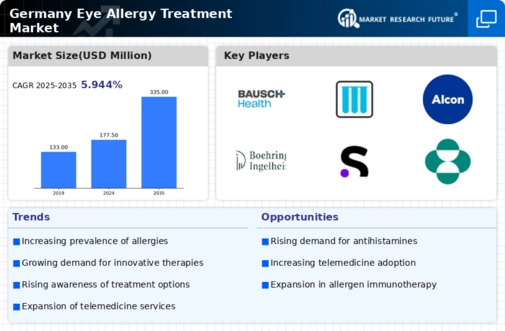Rising Environmental Factors
Environmental factors play a pivotal role in the increasing prevalence of eye allergies in Germany. Urbanization, pollution, and climate change contribute to a rise in allergens, such as pollen and particulate matter, which exacerbate allergic reactions. The eye allergy-treatment market is responding to this challenge by offering a range of products aimed at mitigating the effects of these environmental triggers. For example, air purifiers and specialized eye drops designed to combat environmental allergens are gaining popularity. As the awareness of these environmental impacts grows, consumers are more inclined to invest in preventive measures and treatments, thereby driving the market forward.
Aging Population and Eye Health
The aging population in Germany is a significant driver of the eye allergy-treatment market. As individuals age, they become more susceptible to various health issues, including allergies. The demographic shift towards an older population is expected to increase the demand for eye allergy treatments, as older adults often experience heightened sensitivity to allergens. In 2025, it is estimated that over 20% of the German population will be aged 65 and above, leading to a corresponding rise in the prevalence of eye allergies. This demographic trend suggests that healthcare providers will need to focus on tailored treatment options for older patients, thereby expanding the market for eye allergy treatments.
Increasing Awareness of Eye Allergies
The growing awareness of eye allergies among the German population is a crucial driver for the eye allergy-treatment market. Educational campaigns by healthcare providers and organizations have led to a heightened understanding of symptoms and triggers associated with eye allergies. This awareness is reflected in a reported increase in consultations for allergy-related issues, with approximately 30% of individuals seeking medical advice for eye allergies in recent years. As more people recognize the impact of allergens such as pollen, dust mites, and pet dander, the demand for effective treatments is likely to rise. Consequently, this trend is expected to bolster the eye allergy-treatment market, as patients actively seek solutions to alleviate their symptoms and improve their quality of life.
Advancements in Pharmaceutical Research
Recent advancements in pharmaceutical research are significantly influencing the eye allergy-treatment market. Innovative drug formulations and delivery systems have emerged, enhancing the efficacy and safety of treatments. For instance, the development of targeted therapies and biologics has shown promise in managing severe allergic reactions. The market has witnessed a surge in the introduction of new antihistamines and corticosteroids, which are designed to provide rapid relief from symptoms. In 2024, the market for eye allergy medications in Germany was valued at approximately €500 million, with projections indicating a growth rate of 5% annually. This continuous evolution in pharmaceutical offerings is likely to attract more patients, thereby expanding the market further.
Integration of Telemedicine in Allergy Management
The integration of telemedicine into allergy management is a transformative driver for the eye allergy-treatment market. With the increasing adoption of digital health solutions, patients can now access consultations and treatment plans remotely. This shift is particularly beneficial for individuals living in rural areas or those with mobility challenges. Telemedicine platforms facilitate timely diagnosis and management of eye allergies, allowing for quicker access to necessary treatments. As of 2025, it is projected that telemedicine will account for approximately 15% of all allergy consultations in Germany. This trend not only enhances patient convenience but also encourages more individuals to seek treatment, thereby propelling the growth of the eye allergy-treatment market.






















Leave a Comment